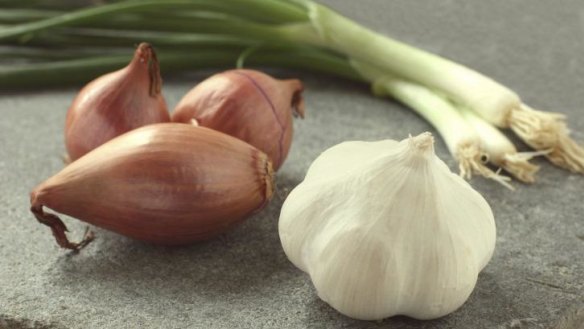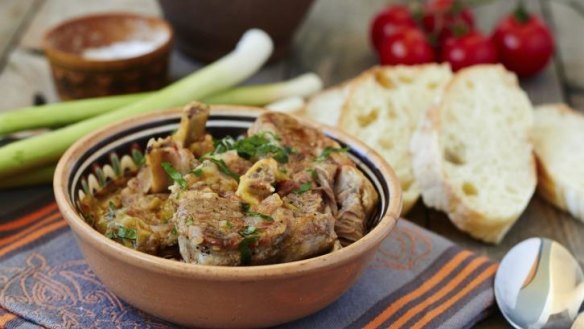Owen Pidgeon's tips for growing garlic in Canberra

We are in the transition period of the year, moving into the cold winter months. So it is timely to think about what we can plant out in the garden now. The members of the allium family of plants come to mind: chives, onions, shallots, garlic and leeks. All of these vegetables can be consumed entirely, apart from the trimmings of their roots. The bulbs, the stems and the leaves can all be in fresh salads and in many cooked dishes especially when they are still tender.
All alliums love to grow in full sun, in a garden bed enriched with compost and old manures. They are herbaceous perennials with tall stems that produce flowers on what is called scapes. They struggle with weeds because they do not have the broad leaf structure of other vegetables so weeding and mulching is part of the deal. And it is a long-term deal indeed, as the allium family are slow growers.
Crop rotation is also important. You should allow a minimum of three years before planting alliums where they have grown before. This prevents a build-up of soil-borne diseases.

The other critical element is water in the right quantities. The setting bulbs of the allium family should never experience drought as they are shallow rooted. The little white roots grow rapidly and spread out in search of moisture and nutrients. The soil needs to be kept moist as the bulbs are forming. However, they hate having wet feet. Garden bed preparation is vital. Be sure to build up the garden bed to allow for excellent drainage.
You will be heart-broken in late spring if after months of careful tending your plants they just rot off. Then, with garlic and onions, make sure that you do not water in the final four weeks before harvest. This is the time when they need to dry out completely.
These plants take six to eight months to complete their growing cycle, so you need to be able to set aside some space in the garden until near Christmas. However, you will then have good, clean garden beds ready for mid-summer vegetable plantings.
The tall stems of leeks can be fried as garnish, steamed or baked. Leeks add real flavour to quiches, to soups and to casseroles.
Onions and their perennial cousins, the shallots, are major contributors to salads and many fines dishes of the kitchen.
Of all the alliums, garlic is the most essential ingredient of much cooking. It has been grown since the Egyptian empire times and there have been remnants found in the tombs. Even back in those days, garlic was provided to the slaves working on building the pyramids, as the means of warding off infections. Garlic has been widely grown in China and India for millennia. The Romans and the Vikings introduced it to Europe.
The famous pink garlic of Lautrec in south-west France traces its beginnings back to a peddler in the Middle Ages who arrived from the East with only the garlic cloves to pay for his lodgings. The local merchants fell in love with this beautiful pink-coloured garlic and since 1959 the town has been hosting an annual Festival of Pink Garlic of Lautrec on the first Friday of August. .
Australia produces only 15 per cent of its garlic needs, at about 500 tonnes. The remaining supply comes from Taiwan, China, New Zealand, Mexico, Argentine and the US, with the biggest supplier being China. We have seen a growing interest in local production in recent years, both commercially and in the home gardens. There are now close to 100 varieties of garlic grown in Australia, so for backyard gardeners the trick is to find varieties suitable for your area.
The Canberra region lies in the cooler, highlands growing zone and this limits the suitable varieties and the best growing times. Now is the time to plant garlic in the cool regions so the cloves have time to sprout and establish a strong root system before the soil temperatures fall too much. Planting in April provides more time for the root systems to develop but you will have to remember to thoroughly weed around the little plants in May. Planting out in early May is still suitable and you will have fewer weeds to contend with but the trade-off is slower root growth. When the garlic shoots are 3cm to 5cm high, thoroughly weed again and spread thick mulch over the bed.
Sourcing good garlic for planting is critical. Do not use imported garlic. As well as being treated with methyl bromide and being irradiated, imported garlic bring with them many exotic viruses. Infected bulbs grow much slower and are generally poor-quality plants. The plant viruses will impact on the local garlic industry and can even spread to native orchids.
For me, the best source is a local, regional garlic grower who maintains high standards and has organic certification, such as Ingelara from near Bredbo. They do not have a broad range of varieties but the ones that they do grow and market are suitable for the Canberra region. Monaro Red and the Australian white are their two main varieties and there will be good supplies at the Saturday morning Capital Region Farmers Market for the next few weeks. The Diggers Club from Victoria are now offering a good range.
It is preferable to buy the largest available bulbs so seek out your supply quickly. From each bulb, set aside the smallest cloves and plant them separately, to produce some "spring garlic". You can harvest the slender garlic stems in September and October and simply chop them up finely and add to your cooking. They will infuse the dishes with that wonderful garlic taste.
The two main groups of garlic are the hard-neck and the soft neck varieties. The hard-neck ones mature first and generally produce larger bulbs. Soft-neck garlics grow more quickly and they need to be planted first
Italian white is a good soft-neck garlic which does not produce a flower stem. It is one of the family of Rocambole garlics with their cloves looping over and it can produce up to 17 cloves per bulb. Rocambole garlics all have good flavour.
Monaro purple and Australian purple are good, mid-season hard-neck varieties that produce high-quality large bulbs. Greek Purple is another good mid-season variety. The Australian white is also a good hard-neck variety that will produce large bulbs with six to eight cloves. For good initiation of the formation of cloves, all these varieties need long, cold winters.
Early purple garlic will produce a crop in late November of large cloves. Glamour is an excellent hard-neck variety which produces 12-16 large, plump cloves with strong flavour. It is a variety that Patrice Newell has developed on her organic farm north of Sydney.
Plant out garlic about 10 cm apart, in rows that are 35-40cm apart. The flat end will develop roots, so make sure that it points downwards. The tops of the cloves should be just below the soil surface. After they shoot, the energy of some plants are such that the roots push the cloves up above the soil surface so you may have to cover the newly emerging bulbs with some additional soil.
Lamb and apple casserole
8 lamb neck chops
1 cup beef stock
1 cup water
2 rome beauty apples
2 onions
2 cloves of garlic, crushed
2 tbs olive oil
3 medium carrots
6 roma tomatoes
salt and pepper
chopped parsley
Heat oil in a large frying pan and brown the chops on both sides (removing all fat). Place the chops in a casserole dish and add beef stock and the extra water. Cover with lid and cook for 30 minutes at 170°C.
Peel, core and cut apples and onions into thick slices. Saute the onions, garlic and sliced apples at medium heat using olive oil. Peel and slice the carrots. Skin the tomatoes and cut into halves. Place the apple/onion mix, sliced carrots and tomatoes to the casserole and season with salt and pepper. Place in oven for another 30-40 minutes. Serve with a sprinkling of parsley, accompanied by steamed beans or broccoli.
This week in the garden
* Plant out shallots and leeks seedlings into well-prepared garden beds.
* Plant broadbeans, shelling peas and snow peas wherever you have some space in the garden. They will provide you with a good winter and early spring crop and a welcome addition of organic matter for later crops.
* Consider planting out a green manure crop which could be a mixture of oats, sub clover, pod vetch, mustard seed, fava bean and fenugreek. The green plants will grow through the winter and then simply dig them back into the garden bed before they begin to flower. This is a good, natural way of boosting nitrogen content in the soil and building up humus levels over the cold months.
* Clean up under fruit trees and add all the fallen leaves to the compost. If you have larger-leafed plants still standing in the garden, such as sweet corn, then chop them up into small sections before adding to the compost.
Owen Pidgeon runs the Loriendale Organic Orchard near Hall.
Restaurant reviews, news and the hottest openings served to your inbox.
Sign up